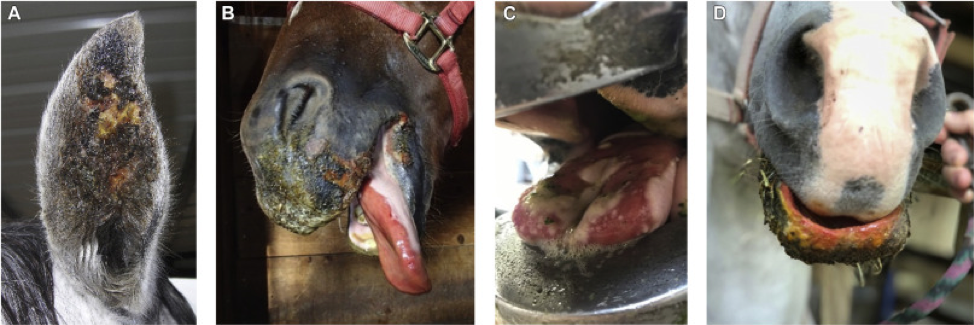
May 2020
Vesicular Stomatitis Virus
By Dr. Maggie Highland
Current and Historic Outbreaks in the United States
On April 12, 2020, the first case of Vesicular Stomatitis Virus (VSV) was confirmed for this year in New Mexico. Within the following 10 days, additional cases were confirmed in Arizona and Texas. As of May 7, 2020, the number of VSV affected premises had grown to 27 (24 confirmed and three suspected), affecting four counties in Arizona, six counties in New Mexico, and three counties in Texas. Of the affected premises, 24 had only horses affected and three had affected cattle.
The following USDA-APHIS website provides details on historic VSV outbreaks and up-to-date information on incidents of VSV in the United States:
VSV emerges seasonally from tropical areas in Mexico, Central America, and Northern South America. Historically, outbreaks in the United States have occurred either annually or years may pass with no cases identified within the United States. While Arizona, New Mexico, and Texas are the most commonly impacted states, previous years have had expansion of VSV into Colorado, Utah, Wyoming, Kansas, Oklahoma, Nebraska, South Dakota, Montana, and Idaho. For example, last year the United States had 1,144 VSV affected premises in eight states (Colorado, Kansas, Nebraska, New Mexico, Oklahoma, Texas, Utah and Wyoming).
Transmission and Clinical Disease (Animals and Humans)
Vesicular stomatitis (VS) is a viral disease caused by members of the genus Vesiculovirus known as Vesicular Stomatitis Viruses (VSV). VS primarily affects equines (horses, donkeys, mules) and to a lesser extent cattle, and even less often pigs, camelids, sheep, and goats. Infected hosts will often show drooling as the first sign of infection, due to the painful blister-like lesions (vesicles) that form in the mouth, which often rupture resulting is painful ulcers. These lesions can also appear on the muzzle, ears, lips, prepuce/sheath, teats, and coronary band. Often the first clinical sign of infection is drooling, due to painful oral lesions, or lameness due to lesions affecting the coronary band. While typically not fatal, the painful lesions often render animals reluctant to eat or drink.
Insects are the main source of infection during outbreaks and can disseminate the virus over long distances. Blood- or tissue-feeding insects, including species of sand flies, Culicoides biting midges, and black flies, have been identified in natural setting to be able to carry the virus. Once a host is infected, lesions will typically appear in two to eight days (incubation period).

|
VSV is also a zoonotic agent that can cause “influenza-like” symptoms (fever, muscle aches, headaches, malaise) that typically last three to five days in humans that become infected. Rarely humans can also develop vesicular lesions on the nose and/or lips and in the oral and/or throat cavities. Rare reports of encephalitis in children also exist. Infection in humans occurs when oral or nasal secretions/droplets or vesicle fluid from infected animals makes contact with the mucous membranes (eyes, nose, oral cavity) or open skin wounds of the human.
Testing for VSV
VS is one of two disease that can cause the described clinical signs in horses and cattle. The other, and certainly far more feared foreign animal disease, is foot and mouth disease (FMD). Due to the clinical similarity, the only way to distinguish between VS and FMD is through laboratory testing. Both VSV and FMD are reportable to state and federal animal health officials (State Veterinarians and USDA-APHIS). Any animal having suspicious clinical lesions should be reported immediately to the state animal health official. Samples, including serum and swab samples of the lesions, must be collected and submitted to the National Veterinary Services Laboratory in Ames, Iowa any time, or to an approved National Animal Health Laboratory Network laboratory that has been officially approved to perform testing during an outbreak.
Decreasing the Risk of Transmission
A recent publication in the Journal of Equine Veterinary Science provides information on management strategies for decreasing the risk of VSV transmission by controlling vectors and the environment of susceptible hosts. This publication has open access availability: https://doi.org/10.1016/j.jevs.2020.103026/
Reference: Peck DE, et al. 2020. Management Strategies for Reducing the Risk of Equines Contracting Vesicular Stomatitis Virus (VSV) in the Western United States. J Equine Vet Sci. 90:103026.
Much of the information provided in this article, including the image, was taken from this publication. KSVDL would like to thank our colleagues at the USDA-ARS Arthropod-Borne Animal Disease Research Unit, in particular Dr. Barbara Drolet, for bringing to our attention this publication and the current relevance and importance of disseminating the content to owners and clinicians.
Maggie Highland, DVM, PhD is a Diplomate in the American College of Veterinary Pathologists and an anatomic pathologist in the Kansas State Veterinary Diagnostic Laboratory at Kansas State University